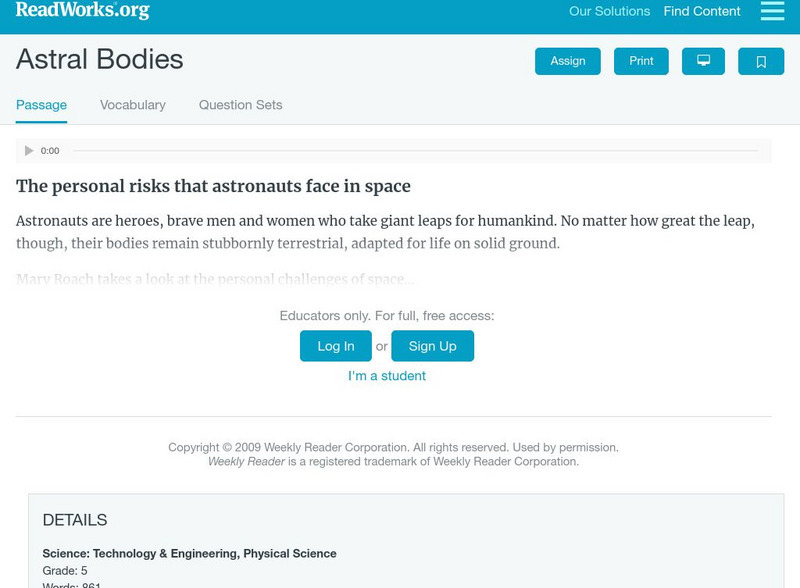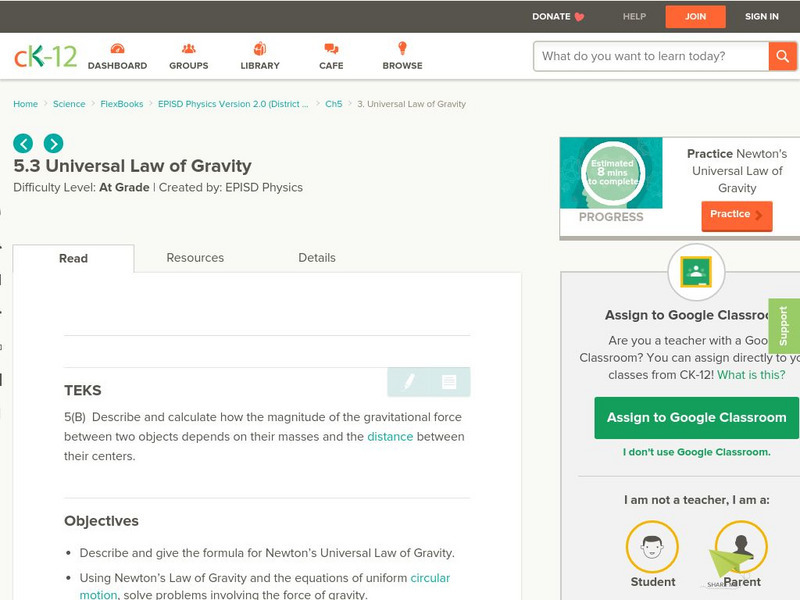Curated OER
Formation of The Solar System
In this science activity, students use basic scientific concepts to complete the series of puzzles that are intended to increase science literacy about the parts and formation of the solar system.
Curated OER
Origami Flight: The Physical Setting
Sixth graders investigate the forces that move certain objects. In this physics lesson, 6th graders design and create paper flying objects using origami methods, which they practice flying in different conditions. Students...
Curated OER
The Mass of the Moon
In this mass of the Moon worksheet, students use the lunar orbit and the orbit period to determine the mass of the Moon. They solve 4 problems including finding the mass of the Moon, determining the ratio of the Moon's mass to the...
Curated OER
Newton's Laws and Winter Sports
Students investigate past winter Olympic games utilizing any skiing or snowboarding event to take Newton's Challenge. Helpful Web resources are provided and students enjoy learning science laws along with researching Olympic events.
Curated OER
Salinity
Learners define and discuss salinity, conduct classroom experiment to determine salinity of water sample by using hydrometer, record predictions, and demonstrate understanding of how salinity influences object's ability to float in water.
Curated OER
Science Quiz-Grade 6
In this grade 6 science quiz worksheet, 6th graders complete a 15 question multiple choice quiz covering a variety of grade 6 concepts.
Curated OER
Chapter 3 and 4 Review
In this physics review worksheet, learners complete 42 matching, fill in blank, and problem solving questions pertaining to Newton's laws, force formulas, distance formulas, and simple machines.
Curated OER
Forces and Machines
In this forces and machines worksheet, students will review vocabulary associated with forces including friction, inertia, and work. Students will also explain how simple machines help to do work easier. This worksheet has 10 matching, 6...
Curated OER
Measurement and Safety
In this measurement and safety activity, students find the terms in a word search puzzle for 13 statements about the SI units of measurement, the prefixes for the units and measurements of mass, length, and volume. They answer 2...
Curated OER
Picket Fence Free Fall
Students measure acceleration using a Picket Fence and a Photogate. In this physics activity, students drop an object and measure the acceleration of the object free falling. They log their data using the TI.
Curated OER
Don’t Sit Under the Apple Tree…You Might Become Famous
Students explore Newton's laws using CEENBoTs. For this physics lesson, students collect data and create tables and graphs. They calculate speed, acceleration and forces using mathematical formulas.
Curated OER
What Floats Your Boat?
Students discover the Archimedes principle through a buoyancy experiment. They measure the water displacement of a lump a clay which is denser than water then reshape the clay into a bowl which floats but displaces more water.
Curated OER
Iron Filings
Students conduct an experiment in which a solution of copper(II) sulfate is added to iron filings. They write and balance the equation for the reaction that occurs and calculate the amount of iron that reacted and the percent yield of...
Read Works
Read Works: Astral Bodies
[Free Registration/Login Required] An informational text about being an astronaut and living in zero gravity. A question sheet is available to help students build skills in reading comprehension.
Science Struck
Science Struck: What Is Gravity and How Does It Work
A very detailed look at gravitational force and the many theories that have been put forward to try to explain it. Includes lots of illustrations.
Curated OER
Wikipedia: National Historic Landmarks in Ohio: Zero Gravity Research Facility
An image of the Zero Gravity Research Facility.
CK-12 Foundation
Ck 12: Universal Law of Gravity
[Free Registration/Login may be required to access all resource tools.] In this online tutorial students will learn to describe and calculate how the magnitude of the gravitational force between two objects depends on their masses and...
PBS
Pbs Teachers: Stationed in the Stars
Examine the factors that impact an astronaut's freefall in space. Differentiate between zero gravity, weightlessness and freefall.
PBS
Nova: Missing in Mi G Alley: All About G Forces
Students learn about G forces. The resource discusses gravity forces, fainting in the air, acceleration, and zero G?s.
Other
Simple Science: Muscle Loss in Space
Learners investigate the effects of zero gravity. The resource has young scholars measure the change in the area of calf muscle from before and after the flight to determine if muscle loss has occurred. Some topics included are muscle...
Physics Classroom
The Physics Classroom: Momentum and Collisions: The Astronaut Catch
Students imagine that they are hovering next to the space shuttle in earth-orbit, and bump into another astronaut of equal mass. If the two astronauts holds onto each other, then how fast do they move after the collision?
PBS
Pbs Learning Media: Free Falling and Weightlessness
Discover the difference between free-falling and weightlessness in this interactive activity from the NOVA: "Stationed in the Stars" Web site.
TED Talks
Ted: Ted Ed: Candy Corn in Space
Watch NASA astronaut Don Pettit create zero gravity candy corn balls on the International Space Station. [2:57]
PBS
Pbs Teachers: Mysteries of the Universe
Consider the issues surrounding the world of space exploration including the new fields of archaeoastronomy and astrobiology. Investigate zero gravity, the Big Bang theory, life in space and how sound travels in a vacuum.



















